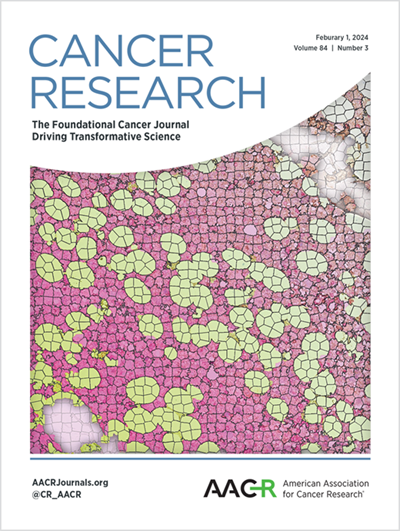Abstract 1900: TORL-3-600, a novel antibody drug conjugate directed against cadherin 17 (CDH17), has preclinical efficacy in colorectal, gastric, and pancreatic cancer
IF 12.5
1区 医学
Q1 ONCOLOGY
引用次数: 0
Abstract
Cadherin 17 (CDH17) is a cell-to-cell adhesion protein that is a member of the cadherin superfamily. In normal tissues, expression of this single pass transmembrane protein is restricted to the lateral surfaces of intestinal and pancreatic ductal epithelial cells. However, in cancer, CDH17 is frequently overexpressed in tumors of the colon, stomach, and pancreas. The selective expression of this cell surface protein in these hard-to-treat cancer makes it an attractive target for the development of antibody-based therapeutics. Here, we describe the preclinical development of TORL-3-600, a novel CDH17-targeting antibody drug conjugate (ADC). CDH17 specific monoclonal antibodies were generated using traditional hybridoma technology and splenocytes isolated from mice immunized with cocktails of NIH3T3 cells overexpressing full length hCHD17 plus purified mammalian expressed hCDH17 extracellular domain protein (aa 23-787). Selective mAb binding was confirmed by flow cytometry and mAb internalization rate was assessed by immunofluorescence (IF). TORL-3-600 was generated from a fully humanized CDH17 mAb by MMAE conjugation with a cleavable linker. Cell membrane staining of CDH17 in patient tumor microarrays (TMAs), cell line (CDX) and patient derived xenografts (PDX) was evaluated by IHC assay. Selective binding of the TORL-3-600 to CDH17 was confirmed in human cancer cell lines and cells engineered to overexpress CDH17. Binding of TORL-3-600 to cell surface CDH17 induced Internalization and translocation to the lysosome of the protein-ADC complex for release of the MMAE payload. Treatment with TORL-3-600 induced significant regressions and tumor growth inhibition (TGI) in four CDH17-positive (CDH17+) human colorectal cancer (CRC) CDXs (103.6 - 140.4% TGI) and three CDH17+ CRC PDXs (63.3 - 102.2% TGI). Responses in these models were sustained for up to nine-weeks following cessation of treatment. Sustained inhibition of xenograft tumor progression was also observed in a cell line model of CDH17+ pancreatic cancer (85.8% TGI). In contrast, greatly reduced responses (37.3 - 58.2% TGI) to TORL-3-600 were observed in the CDH17- human colon cancer CDX and PDX models. Each of the doses tested in this study were well tolerated in mice with no dose-limiting toxicities observed. Analyses of large human patient TMAs by CDH17 IHC assay demonstrated detectable expression of CDH17 in 90.1% (173/193) of CRC, 51.8% (86/166) of gastric and 20.4% (69/331) of pancreatic cancers. These numbers suggest that an ADC directed against CDH17 could provide benefit to a significant number of patients diagnosed with these cancers. These data support the clinical development of TORL-3-600 for the treatment of CDH17+ cancers. TORL-3-600 has completed IND enabling toxicity studies with acceptable PK and toxicity profiles and is now in phase 1 clinical testing (NCT05948826). Citation Format: Neil A. O'Brien, Martina SJ McDermott, Jun Zhang, Ming Lu, Ke Wei Gong, Benjamin Hoffstrom, Wei Ping Jia, Tong Luo, Athena M. Madrid, Min Liang, John A. Glaspy, Dennis J. Slamon. TORL-3-600, a novel antibody drug conjugate directed against cadherin 17 (CDH17), has preclinical efficacy in colorectal, gastric, and pancreatic cancer [abstract]. In: Proceedings of the American Association for Cancer Research Annual Meeting 2024; Part 1 (Regular Abstracts); 2024 Apr 5-10; San Diego, CA. Philadelphia (PA): AACR; Cancer Res 2024;84(6_Suppl):Abstract nr 1900.摘要 1900:针对粘连蛋白 17 (CDH17) 的新型抗体药物共轭物 TORL-3-600 对结直肠癌、胃癌和胰腺癌具有临床前疗效
粘附素 17(CDH17)是一种细胞间粘附蛋白,属于粘附素超家族。在正常组织中,这种单通跨膜蛋白的表达仅限于肠道和胰腺导管上皮细胞的侧表面。然而,在癌症中,CDH17 经常在结肠、胃和胰腺肿瘤中过度表达。这种细胞表面蛋白在这些难治癌症中的选择性表达使其成为开发抗体疗法的一个有吸引力的靶点。在此,我们介绍一种新型 CDH17 靶向抗体药物共轭物(ADC)TORL-3-600 的临床前开发情况。CDH17特异性单克隆抗体是用传统杂交瘤技术和小鼠脾细胞分离产生的,小鼠用过表达全长hCHD17和纯化的哺乳动物表达的hCDH17胞外结构域蛋白(aa 23-787)的NIH3T3细胞鸡尾酒免疫。流式细胞术证实了 mAb 的选择性结合,免疫荧光(IF)评估了 mAb 的内化率。TORL-3-600 由完全人源化的 CDH17 mAb 通过 MMAE 与可裂解连接体连接而成。通过 IHC 检测评估了 CDH17 在患者肿瘤微阵列(TMAs)、细胞系(CDX)和患者衍生异种移植(PDX)中的细胞膜染色情况。TORL-3-600 与 CDH17 的选择性结合在人类癌症细胞系和过表达 CDH17 的工程细胞中得到了证实。TORL-3-600 与细胞表面 CDH17 的结合诱导了蛋白-ADC 复合物的内化和向溶酶体的转运,从而释放出 MMAE 有效载荷。用 TORL-3-600 治疗四例 CDH17 阳性(CDH17+)人类结直肠癌(CRC)CDXs(103.6 - 140.4% TGI)和三例 CDH17+ CRC PDXs(63.3 - 102.2% TGI),可诱导肿瘤显著消退并抑制肿瘤生长(TGI)。停止治疗后,这些模型的反应可持续长达九周。在 CDH17+ 胰腺癌细胞系模型中也观察到了对异种移植肿瘤进展的持续抑制(85.8% TGI)。相比之下,在 CDH17- 人类结肠癌 CDX 和 PDX 模型中观察到对 TORL-3-600 的反应大大降低(37.3 - 58.2% TGI)。本研究中测试的每种剂量在小鼠中的耐受性都很好,没有观察到剂量限制性毒性。通过 CDH17 IHC 检测对大型人类患者 TMA 进行的分析表明,在 90.1%(173/193)的 CRC、51.8%(86/166)的胃癌和 20.4%(69/331)的胰腺癌中可检测到 CDH17 的表达。这些数据表明,针对 CDH17 的 ADC 可以使大量确诊为这些癌症的患者受益。这些数据支持 TORL-3-600 用于治疗 CDH17+ 癌症的临床开发。TORL-3-600已经完成了IND毒性研究,其PK和毒性特征均可接受,目前正在进行1期临床试验(NCT05948826)。引用格式:Neil A. O'Brien, Martina SJ McDermott, Jun Zhang, Ming Lu, Ke Wei Gong, Benjamin Hoffstrom, Wei Ping Jia, Tong Luo, Athena M. Madrid, Min Liang, John A. Glaspy, Dennis J. Slamon.针对粘连蛋白 17(CDH17)的新型抗体药物共轭物 TORL-3-600 对结直肠癌、胃癌和胰腺癌具有临床前疗效 [摘要].In:美国癌症研究协会 2024 年年会论文集;第 1 部分(常规摘要);2024 年 4 月 5-10 日;加利福尼亚州圣地亚哥。费城(宾夕法尼亚州):AACR; Cancer Res 2024;84(6_Suppl):Abstract nr 1900.
本文章由计算机程序翻译,如有差异,请以英文原文为准。
求助全文
约1分钟内获得全文
求助全文
来源期刊

Cancer research
医学-肿瘤学
CiteScore
16.10
自引率
0.90%
发文量
7677
审稿时长
2.5 months
期刊介绍:
Cancer Research, published by the American Association for Cancer Research (AACR), is a journal that focuses on impactful original studies, reviews, and opinion pieces relevant to the broad cancer research community. Manuscripts that present conceptual or technological advances leading to insights into cancer biology are particularly sought after. The journal also places emphasis on convergence science, which involves bridging multiple distinct areas of cancer research.
With primary subsections including Cancer Biology, Cancer Immunology, Cancer Metabolism and Molecular Mechanisms, Translational Cancer Biology, Cancer Landscapes, and Convergence Science, Cancer Research has a comprehensive scope. It is published twice a month and has one volume per year, with a print ISSN of 0008-5472 and an online ISSN of 1538-7445.
Cancer Research is abstracted and/or indexed in various databases and platforms, including BIOSIS Previews (R) Database, MEDLINE, Current Contents/Life Sciences, Current Contents/Clinical Medicine, Science Citation Index, Scopus, and Web of Science.
 求助内容:
求助内容: 应助结果提醒方式:
应助结果提醒方式:


